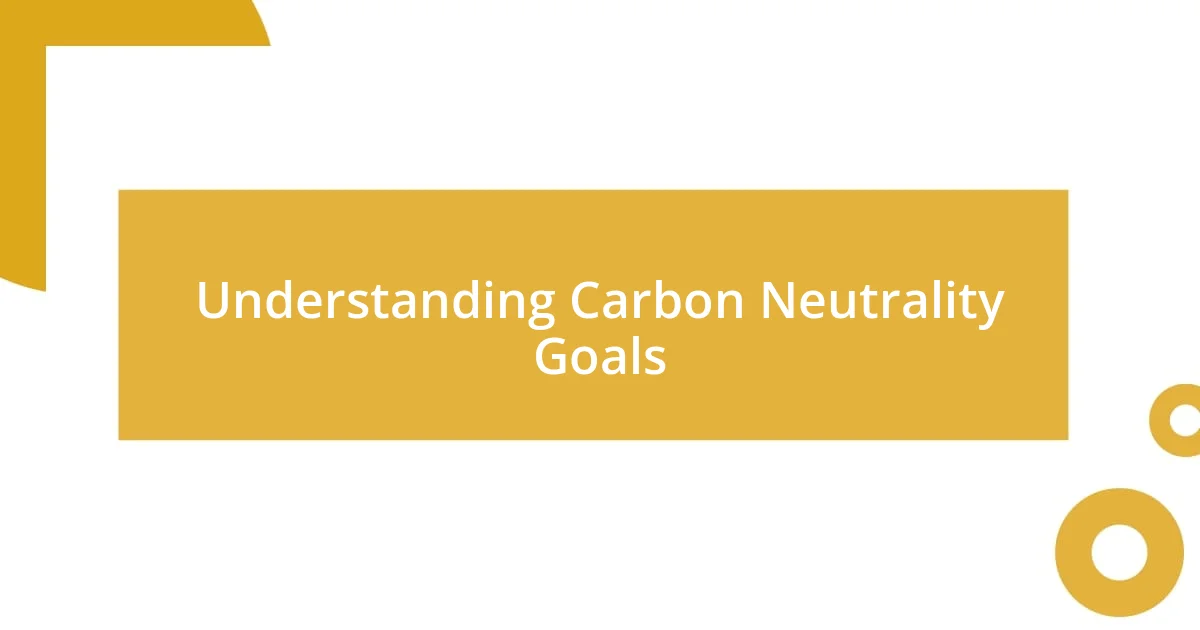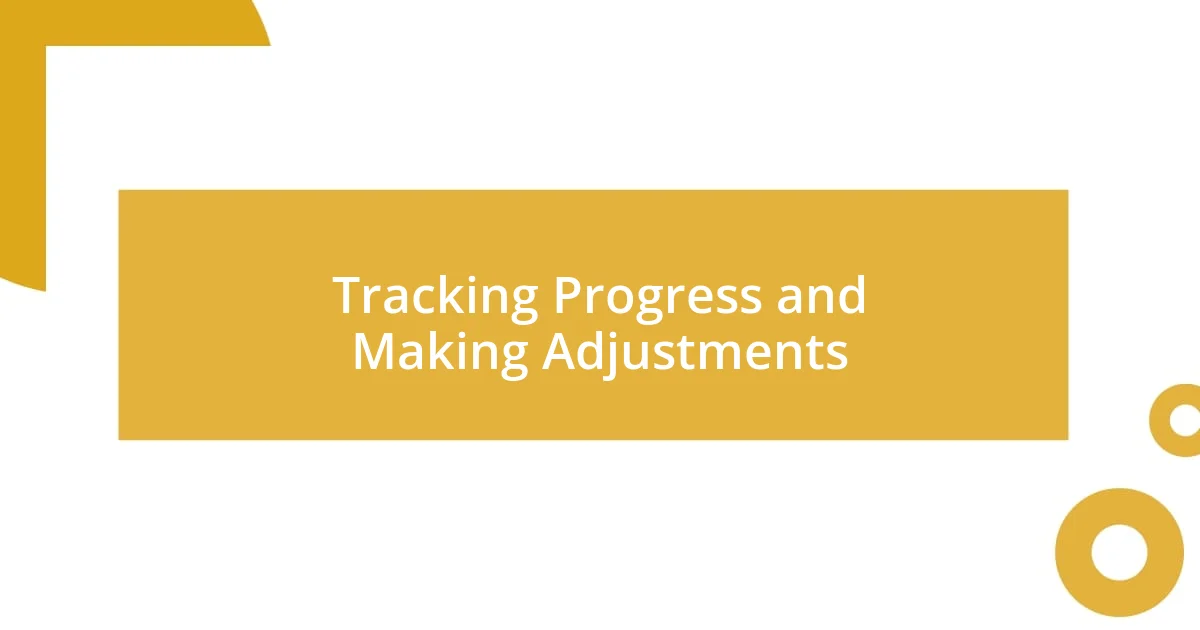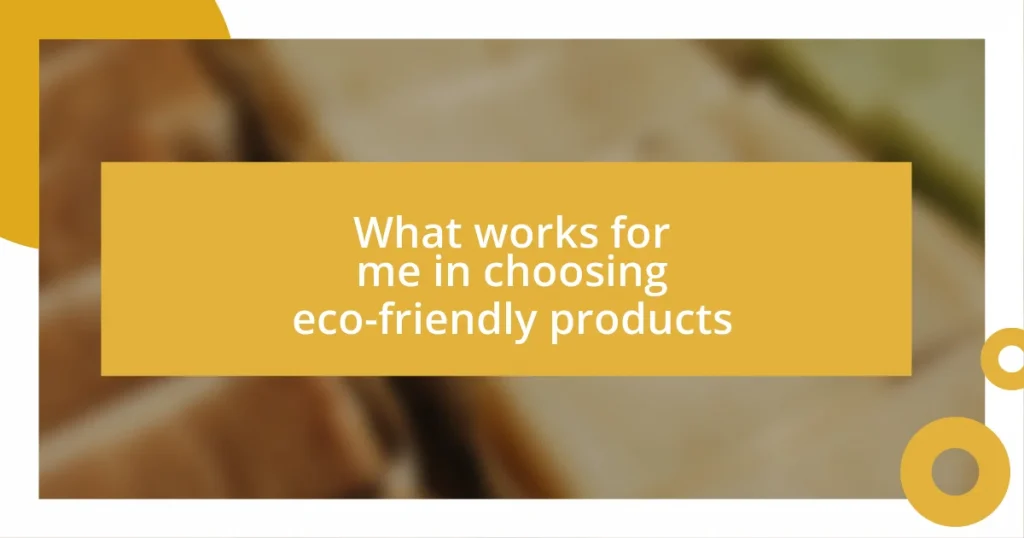Key takeaways:
- Achieving carbon neutrality involves balancing emissions through personal lifestyle changes, such as reducing transportation use and energy consumption.
- Setting realistic, incremental reduction targets helps maintain motivation; tracking progress reinforces commitment to sustainability goals.
- Engaging in community initiatives and compensating for unavoidable emissions, like investing in reforestation projects, enhances collective impact on the environment.

Understanding Carbon Neutrality Goals
When I first learned about carbon neutrality goals, it clicked for me how crucial they are in addressing climate change. Achieving carbon neutrality means balancing the amount of carbon emitted with the amount removed from the atmosphere, often through strategies like reducing emissions and investing in renewable energy. It made me wonder: how can simple lifestyle changes collectively push us toward this goal?
I vividly recall attending a workshop where the speaker shared their journey to carbon neutrality. They were just an average person, like you and me, but their story showed how setting tangible goals—like reducing personal energy consumption—can make a substantial difference. It’s thought-provoking to consider how our daily choices, such as opting for public transport instead of driving, can contribute to a larger, collective impact.
The emotional weight of striving for carbon neutrality resonates deeply with me. It’s not just about numbers or policies; it’s about preserving our planet for future generations. Reflecting on this, I often ask myself: what legacy do I want to leave behind? The answers motivate me to take meaningful steps daily, embracing a lifestyle that aligns with these vital goals.

Assessing Your Carbon Footprint
To effectively assess your carbon footprint, I find it helpful to start with a personal inventory of my daily habits. I always reflect on my transport choices, energy use at home, and even my dietary preferences. I remember when I first calculated my carbon footprint; it was eye-opening. I discovered that simple things, like the amount of meat I consumed or how often I used my car, added up significantly.
Here’s a quick way you can start evaluating your footprint:
- Transportation: Monitor how often you use public transport, bike, walk, or drive.
- Home Energy: Track your energy consumption from heating, cooling, and appliances.
- Diet: Reflect on how your food choices impact carbon emissions.
- Waste: Consider how much waste you generate and whether you recycle.
- Shopping Habits: Think about your frequency of purchasing new items versus reusing or recycling.
Taking these steps to analyze my habits not only made me aware of my own impact but also inspired me to make gradual changes. It was a journey filled with trial and error, but each small step has led me to feel more connected to the climate challenges we face each day.

Setting Realistic Reduction Targets
Setting realistic reduction targets is vital to making our journey to carbon neutrality achievable. I remember when I first attempted to set my own targets; it felt overwhelming. However, I realized that breaking my goal into smaller, manageable steps made the process less daunting. For instance, aiming to reduce my car usage by just one day a week not only felt realistic but also allowed me to explore biking or public transport, which I ended up enjoying more than I expected.
I’ve often heard the phrase, “aim for progress, not perfection,” and I think it perfectly encapsulates the mindset needed here. It’s not about achieving carbon neutrality overnight. For example, when I aimed to lower my electricity use, I started by unplugging devices I wasn’t using. Over time, this simple change not only reduced my carbon emissions but also lowered my bills, which was a delightful bonus.
In considering your own targets, it’s crucial to evaluate what feels attainable for you. Reflecting on my journey, I’ve found it inspiring to keep a journal tracking my progress. Each small victory reminded me that every bit counts, keeping me motivated to strive for more. Setting specific timelines for each target has also been instrumental, as it creates a sense of urgency and accountability.
| Target Type | Example Actions |
|---|---|
| Transportation | Reduce car use one day a week |
| Energy Consumption | Unplug unused devices to save energy |
| Diet | Incorporate one meat-free day per week |
| Waste Reduction | Begin composting kitchen scraps |

Implementing Sustainable Practices
Implementing sustainable practices in my daily life has been a gradual but rewarding transformation. I started with small actions—like bringing my reusable bags when shopping or opting for bulk products to reduce packaging. Every time I make those choices, I feel a sense of accomplishment, as if I’m actively contributing to a larger cause. Have you ever thought about how these tiny changes can have a ripple effect on the environment? It’s fascinating to consider.
One of the most enjoyable sustainable practices I adopted was creating a backyard garden. I remember the first time I harvested tomatoes from my own plants; it was incredibly satisfying to eat food I nurtured myself. Not only did it reduce my carbon footprint by limiting store-bought produce, but it also connected me with nature in ways I hadn’t anticipated. Gardening is both a hobby and a step toward sustainability. Have you thought about growing your own food? Sometimes, all it takes is a small patch of land or even a few pots on a windowsill.
I also began embracing a zero-waste philosophy by limiting my consumption of single-use plastics. Each time I say no to a plastic straw or a takeout container, it feels empowering, as though I’m taking a deliberate stance against environmental degradation. I remember initially struggling with this transition, especially when convenience was at stake. Still, the sense of purpose I gained kept me motivated. Balancing convenience with sustainability may challenge you too, but it can also uncover creative solutions you didn’t know existed!

Utilizing Renewable Energy Sources
Utilizing renewable energy sources has been a game changer in my journey towards carbon neutrality. When I switched to a green energy provider, I remember the excitement I felt knowing that my electricity was sourced from solar and wind rather than fossil fuels. Have you ever considered how empowering it is to align your energy consumption with your values? It truly is an uplifting experience.
Investing in solar panels was another significant step I took. The initial cost can seem daunting, but I found peace in knowing that my investment contributes to a sustainable future. I still recall the day the installation was completed; seeing those panels gleaming on my roof filled me with pride. It felt less like an expense and more like a commitment to making a real difference. And let’s not forget about the savings on my energy bill. How often do we think about the long-term benefits of renewable energy?
I’ve also embraced community initiatives like local solar co-ops. Joining a group of fellow sustainability enthusiasts not only made the process more accessible but also fostered a sense of camaraderie. Sharing knowledge, experiences, and even tips on energy efficiency has been both enlightening and motivating. It made me realize how collective efforts can amplify our individual actions. Have you thought about how community engagement could enhance your renewable energy journey? Together, we can truly amplify our impact.

Compensating for Remaining Emissions
Compensating for any remaining emissions is an integral part of my carbon neutrality journey. After meticulously tracking my carbon footprint, I found that some emissions are unavoidable. This realization led me to explore options for carbon offsets. For instance, I chose to invest in a reforestation project that not only helps absorb carbon dioxide but also nurtures biodiversity. Ever considered the life an old tree contributes to the ecosystem?
I remember the first time I purchased carbon offsets; it felt surreal as if I was directly participating in something greater than myself. It’s intriguing how a simple monetary contribution can lead to planting trees in areas that desperately need it. By compensating for my remaining emissions, I don’t just alleviate my own footprint; I contribute to a legacy of sustainability. Have you ever thought about what it means to leave a positive mark on our planet?
Additionally, I engaged with local initiatives focused on restoring wetlands and natural habitats. This participation has deepened my connection with environmental causes, showing me how my small actions can contribute to larger ecological benefits. The sense of community and collective purpose was invigorating. Are you ready to see how your efforts can foster a thriving environment too?

Tracking Progress and Making Adjustments
As I embarked on my carbon neutrality journey, I quickly realized that tracking my progress was vital. I started by using a simple spreadsheet to log my daily energy consumption and waste production. Each week, as I reviewed the numbers, I could feel my determination grow; it was like having a scorecard for my sustainability efforts. Have you ever tracked your progress toward a goal? It’s a powerful motivator and holds you accountable.
Making adjustments along the way became a natural part of my routine. For example, I noticed that my water usage spiked during the summer months, leading me to explore rainwater harvesting solutions. I still fondly remember setting up my first rain barrel and feeling giddy about the potential to conserve resources. It was a fun and rewarding project that reminded me that small changes can lead to significant reductions in carbon output. What adjustments could you make that would surprise you with their impact?
Additionally, I embraced feedback from my community and the data collected from tracking. Engaging in discussions with fellow eco-conscious individuals opened my eyes to new strategies, like incorporating more plant-based meals into my diet to lower my carbon footprint. I vividly recall the sense of empowerment I felt after a particularly lively potluck where everyone shared sustainable recipes. It made me realize that progress doesn’t have to be a solo mission; the more we share, the more effective our efforts become. Are you open to discovering how collaboration can enhance your journey to sustainability?















